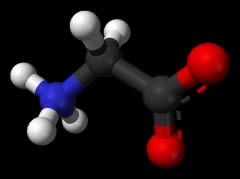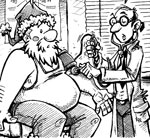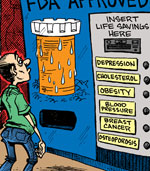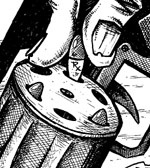Glycine, the Wound Healer
| Share on Facebook | Share on Twitter | Share on Google+ |
Glycine is an amino acid that tastes sweet like sugar, and it is the only amino acid the liver can use in place of glucose.
High insulin levels suck glucose out of the bloodstream into the liver for storage as glycogen. This can make blood sugar levels plummet, with hypoglycemia as the result.
As an alternative to crashing blood sugar levels and severe loss of energy, however, the liver can use the amino acid glycine to make the energy storage molecule glycogen, helping keep blood sugar levels norma.
The body uses glycine to make creatine, the chemical that "pumps up" muscle tissue. Creatine also becomes the raw material for DNA and RNA. The central nervous system uses glycine as a neuroinhibitor, stopping extraneous nerve signals that can cause anxiety and memory loss.
Glycine also becomes hemoglobin, phospholipids, the lipoproteins that carry cholesterol through the bloodstream, and the collagen that holds muscles and tendons together and that gives strength and smoothness to the skin. It is not an "essential" amino acid, but its presence is essential for human life.
A Non-Essential Amino Acid Often in Short Supply
Glycine is a non-essential amino acid, which means that the body can make glycine from other amino acids. The problem sometimes is that the body makes only a small amount of glycine very slowly.

The body can use the amino acid serine to make glycine. Only about 4% of excess serine, however, becomes glycine. The body can also use the amino acid threonine to make glycine. About 20% of excess threonine is used to become glycine.
Another source of glycine is dimethylglycine, but this amino acid can be turned into many other products besides glycine.
Glycine in the Human Diet
Glycine is found in a variety of foods, especially gelatin, also known as Jell-O or jelly. Gelatin is about 33% glycine.
| Food | Mg Glycine Per 200-Calorie Serving |
| Gelatin, Unsweetened | 11374 |
| Gelatin Sweetened with Nutrasweet | 7938 |
| Pork Crackling (Skin) | 4382 |
| Roast Beef | 3242 |
| Chicken Breast | 3124 |
| Spirulina | 2454 |
| Turkey | 2213 |
| Watercress | 2037 |
| Spinach | 1533 |
| Soft Tofu | 1516 |
Glycine is added to many foodstuffs and medications to mask bitterness. It is added to "No-Salt Salt" (potassium choloride) to mask the bitter flavor of the salt substitute. With citric acid, it keeps salad dressings from spoiling. It is used to bind iron in iron supplements and to bind aluminum in antacids, and it is also used to stop stomach upset caused by aspirin.
There is no daily recommended intake for glycine. Even though an adult weighing 70 kilos (154 pounds) uses 70 grams of glycine every day, as little as 3 to 5 grams (3,000 to 5,000 mg) of glycine in the diet can be enough if there are large amounts of other amino acids from which it is made and there is no special need for glycine to make collagen as a repair protein.
Consumin more than about 7% of the diet as glycine is theoretically toxic, causing reduced production of the steroids the body needs to maintain blood pressure. That would correspond to roughly 25 to 50 grams of glycine a day in adults. In practice, toxic effects of glycine supplements have never been observed, but the 25 gram (25,000 mg) maximum is recommended just to be on the safe side.
Using Glycine for Prostate Problems
Glycine supplements, along with alanine and glutamic acid, are given to relieve "retained urine" caused by benign prostatic hypertrophy (enlarged prostate). Retained urine is the sensation of still needing to void urine even after the flow of urine has stopped.
Using Glycine for High Cholesterol and High Triglycerides
The liver uses glycine to make the "balloon" that carries cholesterol through the bloodstream. In one experiment, a single dose of 20 grams (20,000 mg) of glycine lowered both total cholesterol and triglycerides. You are not likely to run into problems if you take a one-time dose of 20 grams of glycine, but you should not take this amount every day.
Using Glycine for Detoxification
Glycine detoxifies benzoic acid, a chemical constituent of BHA and BHT, used as food preservatives, and triggers for allergies, hives, and, some believe, ADD and ADHD.
Using Glycine for Gout
Gout is caused by excess uric acid, and small amounts of supplemental glycine increase the clearance of uric acid out of the bloodstream by the kidneys. You don't want to take a large dose of glycine to try to treat gout. In one experiment, a single 30-gram (30,000 mg) of glycine lowered uric acid levels in the bloodstream for 3 hours, after which the uric acid concentration of the blood plasma rose beyond the initial reading. Small amounts of glycine supplements, no more than 4,000 mg a day, may be helpful in gout.
Using Glycine to Stimulate Growth Hormone
In clinical trials, a single dose of 4,000 to 8,000 mg of glycine stimulated release of growth hormone. A single dose of 12,000 mg also stimulated the release of the hormone prolactin, which increases satisfaction after sex.
Dr. Eric Braverman reports an experiment in which he gave a patient 30,000 mg of glycine and growth hormone production increased 1000%, but a dosage of this size can cause problems for people who have gout.
Using Glycine for Aggressive Behavior
A dose of 3 to 10 grams of glycine, with 1 to 3 grams of inositol, may reduce aggressive behavior.
Glycine and Arginine Together for Healing Wounds and Broken Bones
The combination of glycine and arginine supplements together accelerates healing of skin wounds and broken bones, but taking glycine without arginine may actually slow down the healing process. Take at least 9 grams of arginine along with at least 9 grams of glycine daily for 30 days to support healing wounds and broken bones.
Is Glycine Something I Have to Buy?
Glycine is what I call a "supplemental supplement." There is always another nutrient or change in diet that will be more helpful, but taking 2 to 12 grams (2,000 to 12,000 mg) of supplemental glycine daily may make the difference in prostate problems, gout, aggressive behavior, and healing skin wounds and broken bones.
There are some people who need to use glycine with care:
- Glycine can help calm the manic stage of bipolar disorder, but too much glycine can induce depression.
- Glycine can help an inherited condition caused isovaleric acidemia, in which the pH of the body plummets because of the buildup of a compound called isovaleric acid , but for this condition it has to be taken as a suppository rather than by mouth. Do not use any product intended for oral use as a suppository.
- Glycine interferes with the painkilling effect of morphine and hydrocodone (Vicodin).
- The antiseizure medication Depakote (valproic acid), which is also marketed in a children's dose in a product called Depakene, seems to work by removing glycine from the bloodstream. Taking glycine probably interferes with the action of this medication.
Glycine for Bodybuilders?
There actually is a form of glycine that delivers what the NO or nitric oxide supplements for bodybuilders promise. It is glycine propionyl-L-carnitine, also known as GPLC.
First, a brief of explanation of what NO supplements are. These supplements promise to stimulate the production of nitric oxide in the lining of the arteries for explosive muscle action and greater muscle growth. Almost all NO supplements are some form of L-arginine. And almost all NO supplements have very little demonstrable benefit.

GPLC, however, elevates NO production in well-trained and recently sedentary athletes alike. In one study, formerly sedentary exercisers were assigned to receive GPLC or a placebo and to participate in supervised aerobic exercise for eight weeks. At the end of the eight weeks, the group that had received GPLC had greater NO production.
In a second study, well-trained men doing resistance exercise were assigned to receive either GPLC or a placebo for four weeks. Then four weeks later they received the substance they had not received during the previous test period (every participant receiving both GPLC and a placebo, but at different times during the trial). Men had greater NO production in the forearm when they were given GPLC.
And greater NO production leads to better muscle performance and faster muscle growth.
Insulin increases GPLC retention, so if you take GPLC, you should take it at a carbohydrate-rich meal, when your body will secrete more insulin. Appropriate doses of GPLC range from 1,500 to 5,000 mg a day. The more you "burn" when you do resistance exercise, the more GPLC will do you good.
Selected References:
Bloomer RJ, Tschume LC, Smith WA. Glycine propionyl-L-carnitine modulates lipid peroxidation and nitric oxide in human subjects. Int J Vitam Nutr Res 2009,79:131-41.
Bloomer RJ, Smith WA, Fisher-Wellman KH. Glycine propionyl-L-carnitine increases plasma nitrate/nitrite in resistance trained men.J Int Soc Sports Nutr 2007,4(1):22.
Jacobs PL, Goldstein ER, Blackburn W, Orem I, Hughes JJ. Glycine propionyl-L-carnitine produces enhanced anaerobic work capacity with reduced lactate accumulation in resistance trained males. J Int Soc Sports Nutr 2009,6:9.
-
Skin CareMen Skin Care
-
Free ResourcesFree eBooks
-
The physician should not treat the disease but the patient who is suffering from it.Maimonides
-
Featured Health Supplement
 ...a broad spectrum of around 80 of the nutrients that your body needs…including vitamins, minerals, trace elements, antioxidants,
amino acids, neuronutrients, bioflavonoids, carotenoids, herbal extracts, enzymes and other complementary co-factor ingredients.
...a broad spectrum of around 80 of the nutrients that your body needs…including vitamins, minerals, trace elements, antioxidants,
amino acids, neuronutrients, bioflavonoids, carotenoids, herbal extracts, enzymes and other complementary co-factor ingredients.
-



















